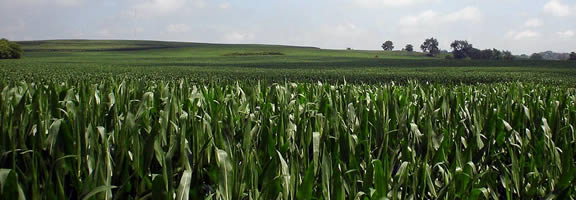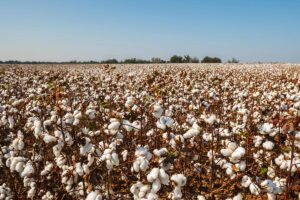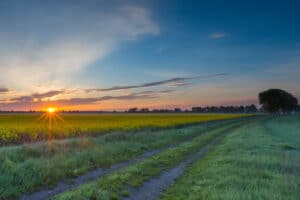I was talking to an agricultural economist in the Midwest a couple of weeks ago, and he said something that caused my jaw to drop. Prime Iowa corn land, he said, was selling for as much as $8,000 to $10,000/acre. And, further, he thought that was a sensible investment for certain buyers.
That didn’t sound right to me, but I wasn’t up to speed on costs and revenues. So I looked at the work that economist Mike Duffy has done at Iowa State University. Duffy estimated costs of crop production in Iowa for 2010.
With yield at 165 bu/acre at a price of $3.62/bushel, Duffy calculates per-acre cost of corn (following corn) at $641 and gross returns at $597, showing a loss of $44 per acre. Duffy’s cost of land was assumed to be $195/a, a cash rental price. Other crops showed a positive return, assuming a cost of $195/a for land. Duffy provides additional examples and cost calculations.
Let’s assume that you were buying this one acre at $10,000 and financing the entire purchase at 7 percent for 20 years. This would involve a monthly payment of $77.53, or $930.36/year. If you subtract the cash rental cost of $195/a from the $641/a cost above and then substitute the $930.35/year cost of 100 percent financing, the total cost per acre amounts to $1,376. This produces an $800/a loss each year for corn following corn.
If you paid $10,000 in cash for that acre, your costs would fall to $446 per acre. You would show a gross return of $597, leaving a gross profit of $151/a. But you would lose, say, a 3 percent return on your $10,000, or $300/a. If you factor in the lost return on the $10,000 into your corn purchase, you’re down about $150/a with an all-cash purchase.
Even at 250 bu/a yield on prime land, the gross revenue would amount to $905/a, or about a $470/a loss with 100 percent financing. (I’m not figuring in the additional costs of getting additional yield.) With an all-cash purchase discounted at 3 percent for lost return, you would come out ahead by $160/a if you had a 250 bu/a yield.
These calculations make me wonder whether a purchase at $10,000/a can be 50 percent, or more, financed and still pencil out for the buyer.
The economist I was speaking to acknowledged that the numbers at $8,000 or $10,000/ acquisition cost would not work for an investor. It works, he said, for local buyers who want to pass land along to heirs, or sell at an appreciated land price, or assume that inflation and increasing productivity will pay off the purchase somewhere down the road.
All three arguments are reasonable. But they are working against a projected loss of between $150 to $800/a. At $8,000 to $10,000 an acre, most buyers would be hoping to stop losing money on the purchase before it ends badly. I wouldn’t buy that land for my own portfolio, and I certainly wouldn’t recommend it to clients.
Assuming 165/bu yield and a $3.62 bu price, corn land (corn following corn) would have to be bought at about $1,500/a to show about a $30/a profit. Thirty dollars an acre is not much. It’s $3,000 profit for 100 acres; $30,000 for 1,000 acres.
The point I’m getting at is simple: Paying too much for agricultural land — or any other type of real property — is not a sensible investment decision.
It’s easy for buyers to be optimistic in assuming that crop prices will increase in the future and yields will increase through technology and better management. And it’s very easy to assume that land values will continue to increase…because they have in the past. I would not bet against any of these factors.
I would, however, bet against all of these factors in combination being enough to offset paying $7,500/a too much at the “get-in.”
Marginal land, rather than prime land, is the better investment for investors. (It may or may not be the better investment for local farmers who are seeking a different mix of returns.)
The best marginal land is capable of being improved. The worst marginal land — the kind that investors should avoid — contains some attribute that cannot be economically improved, or something that will always limit its yield. Soil, for example, that has some immutable property that makes it unsuitable for the buyer’s particular purpose should be avoided.
Corn-ethanol production has inflated the value of Midwest corn land, particularly the most productive land. Ethanol has boosted the price of corn land in other places, as well and has pulled into corn production marginal corn land and land that was being used for other purposes. While I think agricultural land, generally, is a good long-term investment, I’m as wary of bubbles in land as I am in any other investment.
Bubbles go flat. Think of champagne.
This content may not be used or reproduced in any manner whatsoever, in part or in whole, without written permission of LANDTHINK. Use of this content without permission is a violation of federal copyright law. The articles, posts, comments, opinions and information provided by LANDTHINK are for informational and research purposes only and DOES NOT substitute or coincide with the advice of an attorney, accountant, real estate broker or any other licensed real estate professional. LANDTHINK strongly advises visitors and readers to seek their own professional guidance and advice related to buying, investing in or selling real estate.










I always tell my investment buyers that their profit is made when they buy rather than when they sell. I rarely deal in ag land, but I believe the same holds true for large rural tracts. I also appreciated the marginal land comment. I believe these types of tracts have greater percentages of appreciation.
There is NO 100% financing in purchasing commercial farm land. When the 8 to 10000 land this was selling, it involved a 1031X property. Usually carried a multiplier of 5 to 10. That is; a 100ac transitional parcel value would buy 500 to 1000ac of the flat, black Iowa dirt.
Not happening much these days…. most of the developers are out of business. That is one reason your tax dollars are bailing out the banks. We haven’t seen the worst yet. More to come.
In response to Jim’s comments:
My source for this piece is an ag economist in Iowa who also owns farmland. He was talking about a cash payment of $8,000 to $10,000/a of prime Iowa cornland, not a 1031 exchange.
The 100% financing illustrates one end of a financing specturm, the other being all cash with no financing. The article clearly refers to both extremes as well as a middle position. Were I a lender, I would not lend 100 percent on an $8,000/$10,000/acre purchase, but would on $1500/a. Curtis